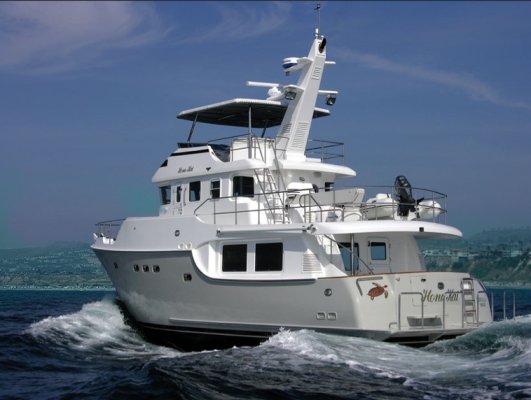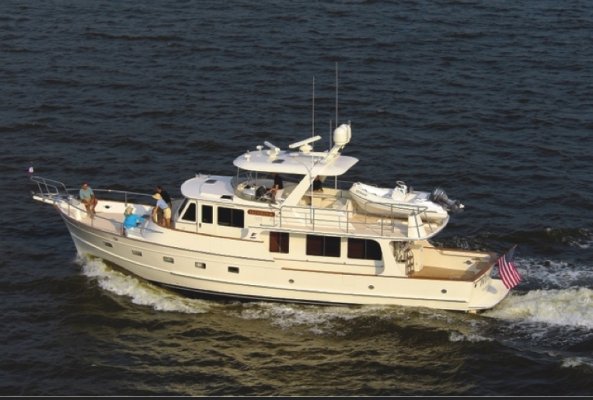It might be useful to talk about what differentiates a coastal trawler from an "ocean crossing capable" boat. We recently decided we want to expand our cruising ground from the coast to the world, and went through the process of examining the differences. Here's a quick sketch of what we came up with.
Good Pilot House: Obviously to make a long passage you need to run 24x7, and this introduces the importance of a pilot house. It's great to have a place that's focused on operating the boat without distractions from people watch TV or whatever. But it also needs to have room for a few people to hang out if desired. And very importantly it needs to be light-isolated from the rest of the boat. You don't want to lose your night vision every time someone needs to move about the boat, and you don't want to constrain what other people do on the boat. A lot of pilot houses don't meet this last criteria. It's also really nice to have a bunk of some sort up there so the off-watch are right at hand if needed.
Seaworthy: This takes a lot of forms and is a very subjective thing. But in general, I think there are two considerations. First is that the average sea state that you run through is likely to be more severe, and you want to be comfortable. Stabilizers are a must. Once you have had them, you will never go back. Weight also matters. The second, and more important thing is that you will be making passages that are longer than the weather forecasting window, so you need to be prepared for rough seas, and the boat needs to be able to handle it. Some boats are built more solidly than others. Some have hatches and glass that can take more or less of a pounding than others. Some locate dinghies where they are safe and some where they will surely be lost.
Redundancy: This takes many forms. Propulsion is probably the most important since towing services aren't available in the middle of the ocean. Some people prefer twin engines, and some prefer a main and wing engine. But more than one engine of some kind reduces your risk of being dead in the water. Then the list goes on. Fuel systems need to be clean, well maintained, and with LOTS of filters. Nearly every account I've read of a power boat getting into trouble traces back to fuel - typically settled crap in the tanks getting stirred up in rough weather, taking out the engines. When you start plugging filters, you are likely to plug a lot of them, so have a case or two on boat, not a filter or two. Water too. if you want to maintain the comfort of a power boat on a long voyage, you need a lot of water which means a water maker. These can be finicky too, and you need to know what you'll do if it totally breaks. Redundant electronics, auto pilots, pumps, etc. Pretty much every Nordhavn gets equipped with fully redundant auto pilots. Manual steering in the wrong kind of seas is exhausting. There are lots and lots of other systems on a boat, and you need to go through a what-if-it-fails exercise on each one. I'm going through it now on the boat we are building and it's a 5 page document just listing each system and a one liner about how to handle it.
Range: If you just want to play in the Atlantic, about 2000nm is needed. For the Pacific it's more like 2700nm. And that needs to account for slower progress in bad weather, currents, mishaps, etc. plus another good margin of error. 10% reserve is often talked about, but I like to see more. Range means carrying lots of fuel and going slow for the best MPG.
One simple test of a boat/brand is to see how common it is for people with a particular boat to do crossings. If it happens all the time you can be pretty sure the boat is capable. If not, it doesn't mean it's not capable - it just means you need to do your homework more carefully.
Under the circumstances where the original poster has little to no boating experience and wants to jump in and cross oceans with her 5 little kids, I would suggest she only consider well-proven ocean going boats. Boats that do this all the time. That way most of the boat issues will have been worked out for you by others, and you will only be left with your own learning curve to become a competent mariner.
They have probably already been recommended to you, but I can suggest two things to read. First is Voyaging Under Power by Robert Beebe. The forth edition was just released, so be sure to get that one. You should also read the blogs, and I think there is a book, of the voyage of Eric and Christi Gribb. With little to no boating experience, they bought a 43' boat and went around the world and lived to tell about it.
One last point. To me there is a big difference between two consenting adults like the Gribbs deciding to go around the world with no significant prior boating experience, and someone with similar lack of experience taking 5 children along. In your case, I would liken it to a captain taking paying passengers where the passengers have an assumption of competence in the captain. This assumption of competence comes in the form of their USCG license which permits them to operate a passenger vessel. If I were you, I would hold myself to no less of a standard than that captain, and would only venture off shore with young children if I had all the same qualifications as a licensed captain, or better yet, held a captains license.
If you held yourself to that standard, and if you were out in your boat every single day for all of July and August (the prime boating season in New England and the time when your kids are not in school), it would take you six years to meet the minimum qualifications for the lowest level of license the USCG issues. To be licensed to carry those passengers across the ocean requires the first license, plus 12 more years, 9 of which have to be off-shore. Just something to think about as you take others on this adventure of yours.




 However, that still does not change my option of the boat its still a fair weather protect water boat, that would make a great ugly live aboard dock queen. a boat I might be interested in.
However, that still does not change my option of the boat its still a fair weather protect water boat, that would make a great ugly live aboard dock queen. a boat I might be interested in.  The GH N-series has many favorable design characteristics (as advertised by Mirage) that I find intriguing. 1.) Supposedly unsinkable due to the Nida-core sandwiched between the fiberglass for the deck and super-structure. 2.) The ability to careen. Each prop has it's own skeg. With the flat bottom, she can be beached if needed for repairs or cleaning. Don't actually know the practicality of doing this but seems desirable if the need arises. 3.) Integral fuel tanks molded into the bottom of the boat which also serves as a a structural part for rigidity. Claim is that the hull is over 1-inch thick solid fiberglass. 4.) Shallow draft for gunk-holing. 5.) Excellent fuel economy for a twin (again advertised) with large fuel tanks (500 gal for N-37) for about a 1500 mile range. 6.) The lazarette. Large space...enough to put a chest freezer down there. 7.) Stand-up engine room (as mentioned).
The GH N-series has many favorable design characteristics (as advertised by Mirage) that I find intriguing. 1.) Supposedly unsinkable due to the Nida-core sandwiched between the fiberglass for the deck and super-structure. 2.) The ability to careen. Each prop has it's own skeg. With the flat bottom, she can be beached if needed for repairs or cleaning. Don't actually know the practicality of doing this but seems desirable if the need arises. 3.) Integral fuel tanks molded into the bottom of the boat which also serves as a a structural part for rigidity. Claim is that the hull is over 1-inch thick solid fiberglass. 4.) Shallow draft for gunk-holing. 5.) Excellent fuel economy for a twin (again advertised) with large fuel tanks (500 gal for N-37) for about a 1500 mile range. 6.) The lazarette. Large space...enough to put a chest freezer down there. 7.) Stand-up engine room (as mentioned).